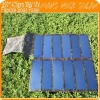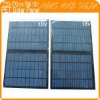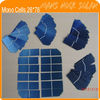125*125 Monocrystalline Silicon Solar Cells 16%-18% Efficiency A grade, nice uniform blue color Reliable parameter Good Pack
A grade 16%, 17%, 18% Efficiency 125*125 Monocrystalline Silicon Solar Cells
Electrical Property
1, Solar Cells Structure
2, Mechanical Date and Design
Format | 125x125mm ±0.5mm |
Diameter | 165±0.5mm |
Thickness | 200±20um |
Weight | 6.7±0.5g |
Front(-) | 1.6mm bus bars (Silver) |
Blue anti-reflecting coating (Silicon nitride) | |
Back (+) | 3mm wide soldering pads (Silver) |
Back surface field (aluminum). |
3, Electrical Parameters
Efficiency cell (%) | Power Ppm(W) | Max Power Current Ipm(A) | Min Power Current Ipm(A) | Short Circuit Current Isc(A) | Max Power Voltage Vpm(V) | Open Circuit Voltage Voc(V) |
18.6 | 2.88 | 5.43 | 5.27 | 5.75 | 0.531 | 0.629 |
18.4 | 2.85 | 5.4 | 5.24 | 5.75 | 0.528 | 0.628 |
18.2 | 2.82 | 5.38 | 5.21 | 5.71 | 0.526 | 0.628 |
18 | 2.79 | 5.33 | 5.17 | 5.67 | 0.525 | 0.627 |
17.8 | 2.76 | 5.29 | 5.13 | 5.65 | 0.524 | 0.626 |
17.6 | 2.73 | 5.25 | 5.1 | 5.63 | 0.522 | 0.625 |
17.4 | 2.69 | 5.22 | 5.07 | 5.62 | 0.52 | 0.624 |
17.2 | 2.66 | 5.19 | 5.04 | 5.61 | 0.517 | 0.623 |
17 | 2.63 | 5.17 | 5.01 | 5.59 | 0.513 | 0.623 |
16.8 | 2.6 | 5.12 | 4.97 | 5.56 | 0.513 | 0.622 |
16.6 | 2.57 | 5.09 | 4.94 | 5.53 | 0.511 | 0.621 |
16.4 | 2.54 | 5.05 | 4.9 | 5.51 | 0.509 | 0.621 |
16.2 | 2.51 | 5.02 | 4.87 | 5.49 | 0.507 | 0.62 |
16 | 2.48 | 4.98 | 4.84 | 5.47 | 0.505 | 0.619 |
4, Feature
MARSROCK has been in the PV industry for many years, our reliability and quality are represented in every solar cell we sell. MARSROCK solar cells offer the following 10 quality advantages:
High Cell-To-Module(CTM) ratio
MARSROCK improve CMT ratio by:
Narrow down efficiency bin rage to 0.2%.
Defining efficiency bin by minimal power and 97% of current max power.
Optimized energy output even in low light or high temperature:
Temperature coefficients average 0.1% per °C lower than the competition. This means 3% less power degradation when cell surface temperature increases from 25°C to 55°C.
Long-term stability and relaibility:
Strong bus bar interconnection ability with minimum peel strength >1.2N/mm.
High quality paste and optimal firing conditions to reduce possible delamination.
Constant pressure cook tests, damp heat tests and peel strength tests.
Low overall breakage rate:
Standard package that meets the long-distance transport of fragile objects packaging requirements.
No beading, thus, lower risk of microcracks from stacking.
Color uniformity among cells and within cells:
Color uniformity, good texture, also looks very comfortable
Visual quanlity:
We can provide you solar cells 125*125mm for home or commercial or industrial etc. We set hight visual quality standards,sreening more than 25 visual criteria. Work time more than 25 years.
Low reverse current:
MARSROCK cells feature low reverse current at both -10V or -12V.
Reduces hot spot risk for long-term reliability
Low LID(light induced degradation)
High shunt resistance
Maximum power output even in low light conditions.
More effectively reduces hot spot risk than only screening reverse current or dark current alone.
Good performance in weak light, therefore better energy yield over the long run.
Envaironmental protection:
REACH-SVHC compliance ensures safe entry into the European market.
ROHS compliance: safe limits of Pb and no Cd found.
5. Production and Quality Control
Classified efficiency grades by both minimum power and power current
Screened for reverse current and shunt resistance
Constant reliability monitoring
Sorted into four defined color classes
Minimal button marks
No beading
Low warpage and bowing
REACH-SVHC and RoHS compliant
How to test solar cells
1. Test machine
2.Test Process
3. Test Result
Especially mentioned that you can’t multimeter to test the solar cells, it is not the right way!
To test solar cell should use the professional equipment, please check above photos to see how we test.
Please noted that, there have many PM points on the solar cells, use multimeter only can touch 1 or 2 PM point, it is hard to make the current come out. You can see our test equipment; there have many metal needles, almost touch the whole solar cell busbar. Normally, to use the multimeter, no matter what kind solar cells, sometime there only very less current come out, like 0.1-0.5A!
Solar Cells Technological Process
Professional & Advanced manufacturing link
A grade 16%, 17%, 18% Efficiency 125*125 Monocrystalline Silicon Solar Cells






